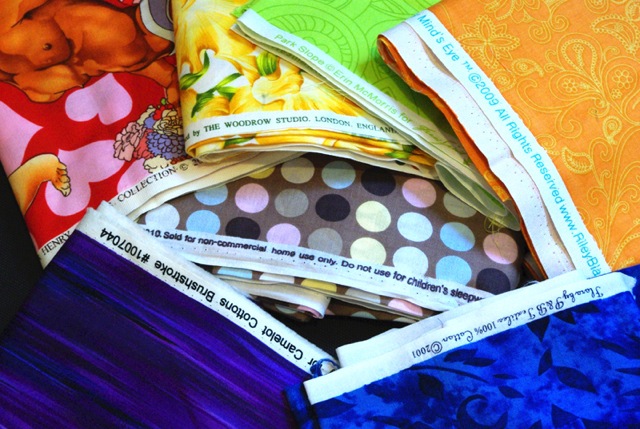 Scene: It’s 1939 and you’re wearing a new dress your mother just stitched up using several feed sacks that used to hold McGookey’s Best Chix Crunch. (Just humor us, okay?) And that snotty Nellie B. makes disparaging remarks about your frock because she thinks Farley Feed has better prints. And all you knew was you liked your dress because it was pink.
Scene: It’s 1939 and you’re wearing a new dress your mother just stitched up using several feed sacks that used to hold McGookey’s Best Chix Crunch. (Just humor us, okay?) And that snotty Nellie B. makes disparaging remarks about your frock because she thinks Farley Feed has better prints. And all you knew was you liked your dress because it was pink.
True story? Who knows? Fabric used to be as anonymous as spit, a nameless commodity judged on whether its color and hand suited the purpose for which it was being bought. This was true in any segment of our culture that used fabric, including quilting.
In fact, quilter and quilt historian Eleanor Levie in her book American Quiltmaking 1970 – 2000 (AQS Publishing, 2004), documents how quilters used to scrape along with a limited supply of fabrics, snatching what they could from blends produced for the garment sewing world. If a quilter in 1972 was able to find about 100 bolts of all-cotton fabric for their creations, they were doing good. But by 1978, after what is commonly thought of as the Great American Quilt Revival, a quilt shop was likely to carry up to 700 bolts of all-cotton fabric made just for quilters. And of course, by today’s standards, that’s just one thread on a double bolt for our industry in terms of available quilting fabrics.
Quilting continued to grow in popularity and the fabric industry met the demand. In 1981 fabric was first given a starring role when Quilter Extraordinaire Jinny Beyer unknowingly launched the designer fabric revolution. She created what is considered to be the first designer quilting fabric collection for V.I.P. and today continues to design fabrics under RJR Fabrics (so sayeth Ms. Levie, whom we love!).
As a quilter, Jinny knew exactly what would happen with her cuts: They’d be chopped up, sewn back together and used in quilts and projects that would be given, sold, used, displayed, shown publicly and loved throughout the world. And probably no one would know Jinny’s name, except the quilters who had the thrill of working with some of her cool (finally!) fabrics.
Fast-forward to a few years ago, and quilting’s huge appetite for edgy fabric has caught the interest of fine artists and designers from other walks of commercial life. They don’t know much about quilting and garment sewing (and this we know from the many interviews and meet-ups we’ve had with these creative dynamos), or have a grasp of the unwritten but deeply ingrained ground rules that stitchers work within, but they’re savvy and know buyers with good taste when they see them. And they like working with in the q-biz because we generally play together nicely.
All is well until cultures collide, as happened several months ago, when a well-known (and highly-talented) fabric designer, a well-known blogger/quilt designer/author (also highly-talented), and her well-known book publishing company (more super talent here) found themselves involved in a conflict over whether a copyright infringement had taken place. (Please note that the fabric manufacturer of the fabric designer’s lines declined to get involved with the issue but we think they’re highly talented as well.) The legal scuffle involved an original quilt design that was worked in large part with one of said fabric designer’s collections. The quilt was included in the author’s book and then the publisher created a tote bag using the image of that quilt to promote the book. Get the deets straight from those involved at these links and we suggest reading them in order from top to bottom:
http://carolinapatchworks.com/blog/2011/11/17/an-interesting-read/
http://carolinapatchworks.com/blog/2012/02/14/resolution-to-an-interesting-read/
http://katespaindesigns.blogspot.com/2012/03/on-copyright-and-tote-bags.html#comment-form
http://carolinapatchworks.com/blog/2012/03/22/more-sides-to-the-story/
Here’s what we’ve got to say about this brouhaha: What we’re seeing here is a natural, evolutionary growing-pain-in-the-quilted-butt, and completely predictable with the progression of our q-niverse’s expanding appeal and reach to other artistic sources. It’s a teachable moment, folks, one that forces us to stop and review the finer points of copyright and intellectual property law, and to develop a practical perspective on how it all applies to quilting and sewing.
If the kerfuffle hadn’t happened with its current cast of characters, it would’ve been some other bunch of folks. We’re not listing names here; the post links above will take you directly to all of the players involved. We believe the bigger issue here is the balance between respecting someone’s original work (art used in fabric designs) against the needs to freely create, market and promote another person’s creative work (quilt designs) in a medium (quilting) that naturally brings together a variety of source goods. This is the most important thing to take away from this debate (unless you’re one of the players involved, in which case we’ve got some Cabernet, chocolate and Advil for you all!).
One major hallmark of the quilt biz is that we do all generally play well together. It’s unusual for conflicts to come up, especially in the public eye. Quilt pros get the perks of cross-promotion while still revering independent creation. We know that at the end of the day, when our quilting guys and gals are turned on enough by our efforts to open their wallets and change the needles on their machines, we all benefit.
What we don’t want is for our hands to be tied when it comes to creating, and frankly designers need the flexibility to have their fabrics used. Which means that like it or not, we’re in a partnership with each other and that requires reasonable guidelines so the partnership works to benefit all partners.
Our understanding is that C&T Publishing, in direct response to all of this, will solicit cooperation from fabric companies for full disclosure of their marketing practices to prospective fabric designers (i.e. they’re going to give fabric to quilt designers for promotional purposes that include designing quilts with said fabric), and also from authors who will be asked to give credit where credit is due within the pages of their books to the best of their ability. C&T acknowledges that it will be impossible to enforce the author’s end of this because some fabric just can’t be easily identified. (Picture trying to remember where that 2” scrap in your border came from when you made the quilt a decade ago!) We applaud and support their efforts and pray this will not in any way lead to the chilling of our quilting mojo for future endeavors.
People, remember, we’re all in this crazy, wonderful, creativity-filled obsession together. Respect each other’s original work and help lift each other’s efforts beyond the paper-pieced stars of our heavens. Use common sense. And communicate, because we need to and because we’re supposed to be good at it. (Art is the ultimate form of communication, is it not?) Let’s not turn our industry over to the lawyers, please? Unless, of course, they want to start doing some stitching. Then we’ll talk, over Cabernet and chocolate, please.
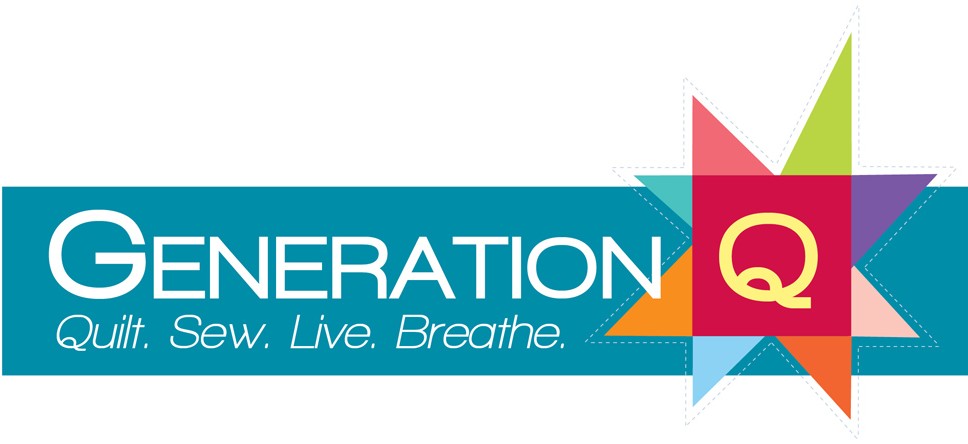
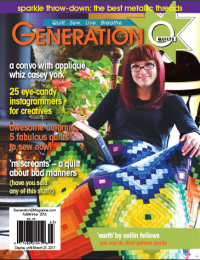



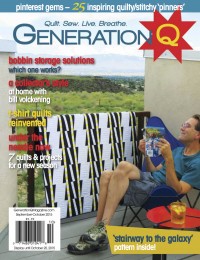
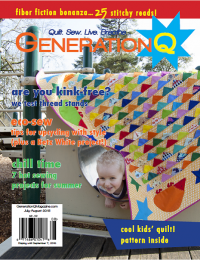
COMMENT #1
What a mess. Also, a little scary for us pattern designers. Pass the chocolate.
COMMENT #2
Thanks for pulling together both sides of the kerfuffle. Interesting stuff from an academic point of few, my IP lawyer husband and I enjoyed discussing it. I’m sorry real people were involved. I do think that there is good case for an implied license and it’s a shame that we are all going to live in fear of being sued now. I think this negative publicity will do the fabric designer a lot of harm and in retrospect this action was ill advised.
COMMENT #3
After reading the above article and the links, this whole matter sparks a question: If the designer and her attorneys can threaten a lawsuit for the use of her fabric in a quilt, what is the implication for a quilter making a quilt and entering it into a quilt show and winning a major prize, without giving a list of designers, manufacturers and suppliers of the fabric, thread, batting, etc., and which retailers the quilter purchased all the supplies to make the quilt? Will the quilter have to list what kind of sewing machine, rotary cutters, mats, etc., she used in making the quilt? We have become a sue-happy nation and we all just need to relax a bit and enjoy the beautiful work that people are doing.
COMMENT #4
Man, what a schmozzle. I guess I don’t have enough to do because I actually read through 90% of all the comments on the various posts and what appalls me more than anything about this (what do people expect once lawyers get involved anyways?) is the way so many commenters seem to be completely and utterly missing the point which is, as interpreted by me, that the publishers used the unattributed fabric line itself, to which they had no rights (NOT the quilt made from the fabric), on a tote bag which they then sold to promote the book. The lawyers were brought in, went overboard, things got very scary and this is when the book came into the scenario. If the tote hadn’t been sold then the book would have been fine. But now we have people rushing to-and-fro saying they’ll never use Designer A’s fabric/never use designer fabric/stop blogging/stop quilting/they hate designer A/hate pattern designer B… I see fault on all sides to be honest and I don’t think anyone comes out looking good; and because there is claim and counter-claim no-one knows what to think. I took the time to read through the comments and there are some very reasonable and informative ones, but right after one of those there will be a Chicken Little one and on it goes. Wouldn’t it be nice if a non-scary lawyer actually wrote an easily understood post dealing with specifically this issue and calmed everyone down?
COMMENT #5
Fascinating! I’m just an ordinary quilt maker – no sales of patterns or quilts – no blogs or books. But information like this is very relevant to how I see my journey through quiltmaking. Thank you for providing such a thought-provoking entry.
COMMENT #6
My understanding of this whole thing is that it was the tote bag that caused the problem. Making the quilt and including it in the book was fine (giving credit to the fabric designer of course). I think where we need to be careful is in using images of quilts on other products, especially if the quilt is made from just one line of fabric. I doubt this would have been an issue if the quilt in question had been a scrap quilt.
It seems to me that the lawyers in this case painted with an overly broad brush and caused a lot of unnecessary confusion.
COMMENT #7
I have been following this subject with interest and think maybe here is a good place for my comments.
First, I do design woven fabrics for a mill. That means the mill owns all the rights to the weaves I produce. I have been trained to copyright, and in the domestic textile industry as a whole, we have been through the ringer with our products being ripped off overseas, sold back in the USA and had our industry decimated. I understand.
Second, I am a quilt maker. I design my own patterns. I sell my quilts.
Now, I know most print textile designers want to retain the rights to their art work which becomes the surface pattern of the fabric. Fine. What is not fine with me is determining what I can do with my finished quilt. So, my resolution is to make my quilts using solids (perfectly acceptable in the modern world), dying my own fabrics, and creating my own designs and digitally printing them. So, in my eyes, the mill that produces the solids as well as the greige goods still makes their money. The digital printer makes money. I get to make my quilts and sell them. What is sad here, is the artist misses out on the exposure and dollars. And the disclaimer printed on selvedges is not sufficient. When I do see a disclaimer, “for non-commercial use only” I put it back. It will be interesting to see how this issue is worked out.
COMMENT #
I guess I would be happy if all I needed to do is credit the fabric designer. I do not want to have to seek out a license to use the fabric. I always the thought the purchase of the fabric, and the exchange of money, was an implied license.
On the other hand, it is not cool for a marketing department to rip off the designs and reprint them without permission.
Either way, it is just sad for 2 nice, talented people to go through this.
COMMENT #8
I have followed this issue since it erupted, and no one seems to be addressing the elephant in the room. The trend has increasingly become to rely on a particular line of fabric from a designer, often exclusively, in a quilt. The fabric manufacturers love this and sell accordingly. It seems inevitable that this is going to lead to just such legal questions as have arisen in this case. The quilting community will have to come to some agreement on “ownership” if this trend continues. Perhaps as quilters we should ask ourselves if we are simply acting as a mirror of a designer rather than using fabric more creatively and originally. This is the issue which manufacturers, designers, and many quilters do not want to address.
COMMENT #
Normally I would not comment on a post from over a year ago, but this is an EXCELLENT point. Fabric manufacturers love selling “collections” of fabrics, especially as precuts, and frequently they hire pattern designers to create patterns exclusively using a single collection of prints, which the manufacturer then offers as a free pattern to spur sales of the fabric collection. Beginning quilters and those who enjoy the sewing but don’t feel confident about their design abilities love the convenience of buying within a fabric collection so they know everything will “go together,” but you’re absolutely right about the resulting “collection quilts” often being more of a derivative of the fabric designer’s artwork than an original artwork created by the quiltmaker.